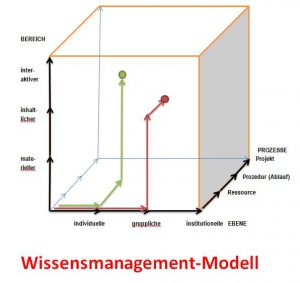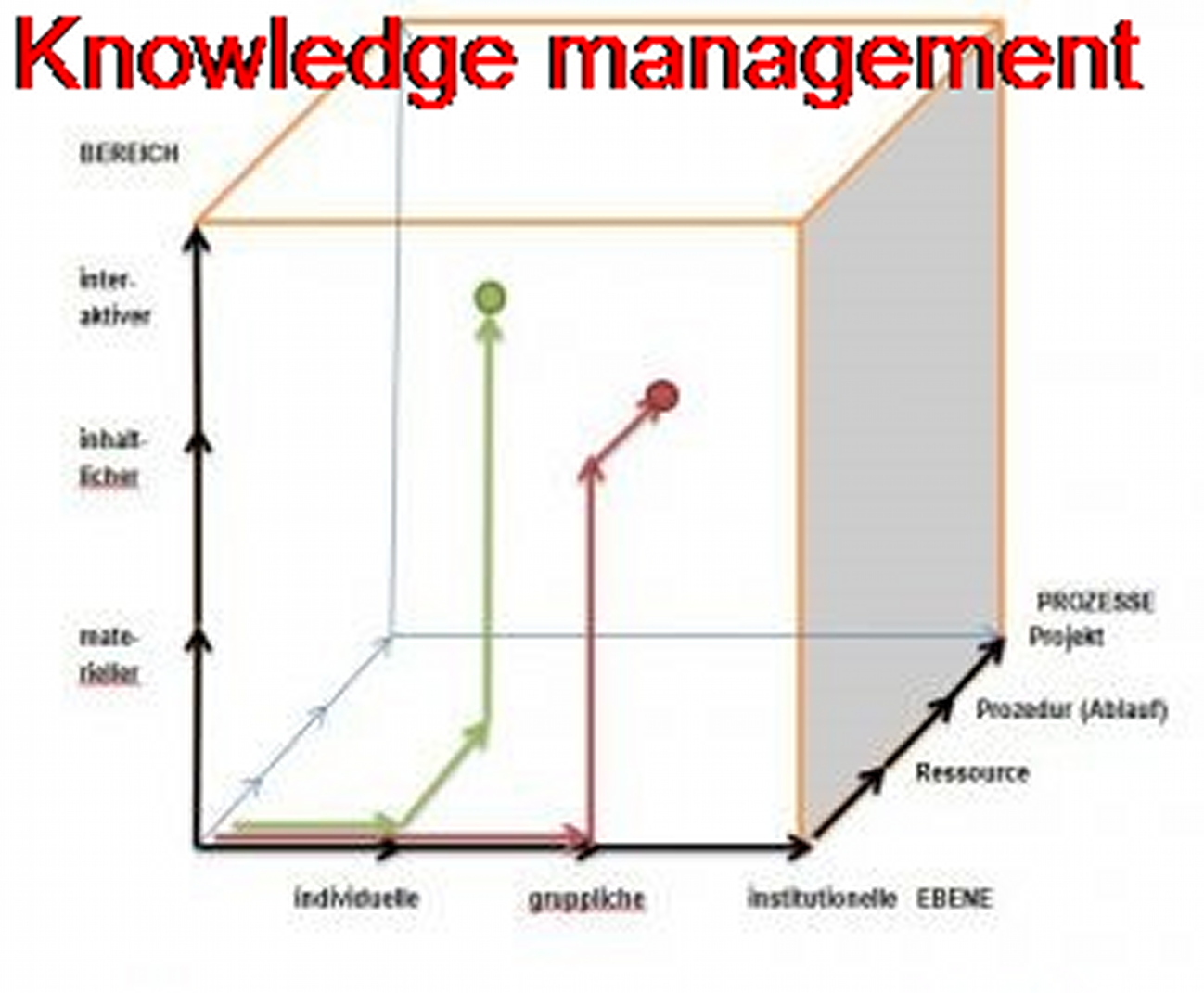Was ist Wissensmanagement? Was ist Wissen?
English version: Scroll down!
Grundlegend für den Terminus ‚Wissensmanagement‘ ist der Wissensbegriff. Demnach liegt Wissen in verschiedenen Kategorien (apriorisch, aposteriorisch, apodiktisch, assertorisch) sowie in verschiedenen Arten (deklarativ, prozedural, metakognitiv; distribuiert) vor; es beruht auf der sinnvollen Verarbeitung und Verknüpfung von Daten und Informationen. Es wird deutlich, dass der ‚Umgang‘ mit Wissen (‚Wissensmanagement‘) sowohl auf einer individuellen als auch auf einer sozialen Ebene stattfindet, wobei sich letztgenannte in zwei weitere Ebenen, in Gruppen und Institutionen, aufgliedern lässt.

Auf diesen drei Ebenen kristallisieren sich mindestens drei Bereiche heraus, die sich – wie die Ebenen – (‚ganzheitlich‘) verschränken: Materie, Inhalt und Interaktion. Dabei ist mit ‚Materie‘ die sinnlich erfassbare und veränderbare Welt gemeint. Mit ‚Inhalt‘ sind die daraus gewonnenen virtuellen interpersonalen Wissensbestände und mit ‚Interaktion‘ ist der inter- und intrapersonale Austausch dieser Inhalte via Kommunikation angesprochen. Diese neunteilige Matrix wird vom gesellschaftlichen Umfeld der so genannten ‚Wissensgesellschaft‘ umschlossen.
Auf der individuellen Ebene zielt Wissensmanagement inhaltlich auf Kompetenzen wie z. B. Methoden- oder Medienkompetenz. Dieser personale Umgang mit Wissen hat eine äußere und eine innere Komponente. Die äußere umfasst den individuellen Umgang mit Wissen, das außerhalb des menschlichen Bewusstseins existiert, die innere Komponente meint das Management des Wissens innerhalb des menschlichen Selbstkonzeptes bzw. innerhalb der Lernstrukturen von Menschen. Weiter beinhaltet Wissensmanagement auf dieser Ebene Informationstechnologien und -techniken, die nicht nur auf Computer (Internet), sondern auch auf ältere, gedruckte, bildhafte Wissensspeicher zurückgreifen und unter anderem Zeit oder materielle Ressourcen erfordern.
Auf der Gruppenebene zielt Wissensmanagement auf das ‚kollektive Gedächtnis‘, das durch Austausch und Partizipation von Wissen entsteht und eine ‚kollektive Intelligenz‘ schafft. Als Ergebnis- oder Aktivitäten-Dokumentation kann es in technisch diversen Inhalten vorliegen und als externer Wissensspeicher von anderen genutzt werden. Ebenso zielt Wissensmanagement auf der Gruppenebene auf Kommunikation und auf eine kooperativ konstruierte Entwicklung. Über menschliche Bereiche wie Interessen, Kenntnisse oder Erfahrungen wird via (moderner) Technologien kommuniziert. Es werden zudem Gruppenstrukturen und Arbeitsteilungsprozesse sichtbar, so dass ein Bedarf an Kooperation, Koordination und Integration der Wissensinhalte entsteht.
Auf der institutionellen Ebene spielt neben dem oben Genannten der inhaltlich-strukturelle Bereich eine besondere Rolle. Das bedeutet, dass innerhalb einer Institution beispielsweise die (Innen)Architektur, die technologischen Voraussetzungen oder die Organisationsstruktur so gestaltet sind, dass die Bedingungen zum bewussten, gezielten, nachhaltigen Umgang mit Wissen innerhalb einer ‚lernenden Organisation‘ gegeben sind.
Die diese Ebenen umschließende ‚Wissensgesellschaft‘ zielt darauf ab, ihre Lebensgrundlagen auf reflektiertem und bewertetem Wissen weiterzuentwickeln, um diese bewusst, lebenserleichternd und nicht zerstörerisch zu gebrauchen. Neben der Verschränkung von Ebenen (individuell, grupplich und institutionell) und Bereichen (Materie, Inhalte, Interaktion) erweitert sich das Modell noch um die Kategorie Prozesse (Ressource, Prozedur, Projekt), so dass man eine Kreuzung von insgesamt 27 Feldern erhält, mit Hilfe derer sich eine Organisation charakterisieren lässt. Man spricht jetzt von einem Wissens-System-Management, dessen Ausführung in unserem Zusammenhang ebenso wie die Zukunftsperspektive zu weit führen würde. Die künftige Weiterentwicklung dieses so verstandenen übergeordneten Nutzungskonzepts Wissensmanagement wird vermutlich in Richtung einer ‚Wissensökologie‘ gehen. Das bedeutet, dass der Qualitätsaspekt im Umgang mit Wissen eine größere Rolle als bisher spielen und z. B. die Entsorgung von Altwissen, die Probleme des Nichtwissens oder die gesellschaftlichen Konsequenzen des Wissens mehr in den Vordergrund stellen wird. Konkreter ausgedrückt umfasst das so analysierte ‚Wissensmanagement‘ auf allen Ebenen ein Bündel von Aufgaben, wie beispielsweise
- Informationen finden, aufnehmen, verarbeiten, reflektieren, bewerte
- Informationen in Kontext einbetten, mit Bedeutung versehen, aus Informationen Wissen konstruieren
- Wissensinhalte in einem kollektiven Gedächtnis speichern
- Wissensinhalte an andere weitergeben, vermitteln, verteilen
- Wissensinhalte mit anderen kooperativ austauschen und gegenseitig ergänzen
- Wissen anwenden und in Handeln umzusetzen
- Wissensbasiertes Handeln bewerten
- Erlernen der oben genannten Teilaufgaben des ‚Umganges‘ mit Informationen und Wissen
- ‚Wissenspflege‘ (wie Aktualisierung, Eliminierung, Strukturierung) betreiben
- Wissen kreativ neu entwickeln
- Wissen transferieren etc.
Zusammengefasst beinhaltet ‚Wissensmanagement‘ Wissensproduktion, -reproduktion, -distribution, -verwertung und -logistik auf der individuellen, grupplichen und institutionellen Ebene. Es umfasst die gezielte und nachhaltige Nutzung kollektiver Intelligenz auf diesen Ebenen, wobei – innerhalb dieser – die drei Bereiche Materie, Inhalte und Interaktion aufeinander abgestimmt sind. Man meint also nicht nur einen (engen) kognitiven, methodischen oder technologischen Aspekt (Gestaltung, Entwicklung und Verwaltung von Wissen), sondern (erweitert aufgefasst) eine Haltung, einen Entwicklungsprozess, der einen bewussten, elaborierten Umgang, die Speicherung und Weitergabe der immateriellen Ressource ‚Wissen‘ beinhaltet.
Siehe auch: WiMa Literatur! Click here!
Siehe auch: WiMa Weblinks! Click here!
English version:
Knowledge Management
Fundamental to the term ‚knowledge management‘ is the concept of knowledge. According to this, knowledge exists in different categories (a priori, a posteriori, apodictic, assertoric) as well as in different types (declarative, procedural, metacognitive; distributive); it is based on the meaningful processing and linking of data and information. It becomes clear that the ‚handling‘ of knowledge (‚knowledge management‘) takes place on both an individual and a social level, the latter of which can be broken down into two further levels, groups and institutions.

On these three levels, at least three areas crystallize which – like the levels – intertwine (‚holistically‘): matter, content and interaction. Here, ‚matter‘ refers to the world that can be sensually grasped and changed. Content‘ refers to the virtual interpersonal knowledge gained from it, and ‚interaction‘ refers to the inter- and intrapersonal exchange of this content via communication. This nine-part matrix is enclosed by the social environment of the so-called ‚knowledge society‘.
At the individual level, knowledge management is aimed at competencies such as methodological or media competence. This personal handling of knowledge has an external and an internal component. The outer component includes the individual handling of knowledge that exists outside of human consciousness, the inner component means the management of knowledge within the human self-concept or within the learning structures of people. Further, knowledge management at this level includes information technologies and techniques that rely not only on computers (Internet) but also on older, printed, pictorial knowledge repositories and require, among other things, time or material resources.
On these three levels, at least three areas crystallize which – like the levels – intertwine (‚holistically‘): matter, content and interaction. Here, ‚matter‘ refers to the world that can be sensually grasped and changed. Content‘ refers to the virtual interpersonal knowledge gained from it, and ‚interaction‘ refers to the inter- and intrapersonal exchange of this content via communication. This nine-part matrix is enclosed by the social environment of the so-called ‚knowledge society‘.
At the individual level, knowledge management is aimed at competencies such as methodological or media competence. This personal handling of knowledge has an external and an internal component. The outer component includes the individual handling of knowledge that exists outside of human consciousness, the inner component means the management of knowledge within the human self-concept or within the learning structures of people. Further, knowledge management at this level involves information technologies and techniques that rely not only on computers (the Internet) but also on older, printed, pictorial knowledge repositories, requiring, among other things, time or material resources.
At the group level, knowledge management aims at the ‚collective memory‘ created by sharing and participation of knowledge, creating a ‚collective intelligence‘. As documentation of results or activities, it can exist in technically diverse content and be used as an external knowledge store by others. Similarly, knowledge management at the group level aims at communication and cooperatively constructed development. Human areas such as interests, knowledge or experience are communicated via (modern) technologies. Group structures and work division processes also become visible, creating a need for cooperation, coordination and integration of knowledge content.
At the institutional level, in addition to the above-mentioned, the content-related structural area plays a special role. This means that within an institution, for example, the (interior) architecture, the technological prerequisites or the organizational structure are designed in such a way that the conditions for conscious, targeted, sustainable handling of knowledge within a ‚learning organization‘ are given.
The ‚knowledge society‘ encompassing these levels aims to further develop its livelihoods on reflected and evaluated knowledge in order to use it consciously, in a way that facilitates life and is not destructive. In addition to the interweaving of levels (individual, group and institutional) and fields (matter, content, interaction), the model is extended by the category of processes (resource, procedure, project), so that one obtains an intersection of a total of 27 fields, with the help of which an organization can be characterized. One speaks now of a knowledge system management, whose execution would lead in our context just like the future perspective too far. The future further development of this superordinate utilization concept of knowledge management understood in this way will probably go in the direction of a ‚knowledge ecology‘. This means that the quality aspect in dealing with knowledge will play a greater role than in the past and will, for example, place more emphasis on the disposal of old knowledge, the problems of non-knowledge or the social consequences of knowledge. In more concrete terms, ‚knowledge management‘ analyzed in this way encompasses a bundle of tasks at all levels, such as.
- Finding information, recording it, processing it, reflecting on it, evaluating it
- embedding information in context, providing it with meaning, constructing knowledge from information
- Storing knowledge content in a collective memory
- Passing on, communicating, distributing knowledge content to others
- Exchange knowledge content with others in a cooperative way and add to it mutually
- Apply knowledge and transform it into action
- Evaluate knowledge-based action
- Learning the above mentioned subtasks of ‚handling‘ information and knowledge
- Carry out ‚knowledge maintenance‘ (such as updating, eliminating, structuring)
- Developing knowledge creatively
- Transfer knowledge etc.
In summary, ‚knowledge management‘ includes knowledge production, reproduction, distribution, utilization and logistics at the individual, group and institutional levels. It encompasses the targeted and sustainable use of collective intelligence at these levels, whereby – within these – the three areas of matter, content and interaction are coordinated. One means thus not only a (narrow) cognitive, methodical or technological aspect (organization, development and administration of knowledge), but (extendedly understood) an attitude, a development process, which contains a conscious, elaborated handling, storage and passing on of the immaterial resource ‚knowledge‘.
Translated with www.DeepL.com/Translator (free version)